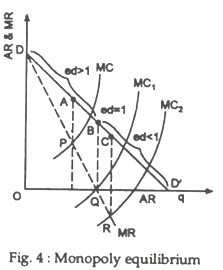Get the answer of: Why does the Monopolist Operate on the Elastic Part of the Demand Curve?
A monopolist wishing to maximise profit produces the output up to that amount at which MC = MR. But it is said that no monopolist will ever fix the output for his product at any level where demand for his product is inelastic (i.e., ep < 1), it would be always possible on the part of a monopolist to increase his total revenue by restricting output (and thereby raising the price).
Similarly, in such a case total receipts will always be falling as output increases (and thereby reducing the price) and so marginal revenue becomes negative. On the other hand, as marginal cost is positive and rising one, in an equilibrium situation any reduction in output for raising the price would cause marginal cost to fall.
So, if a monopoly firm raises the price for his product through the reduction in output, it would increase total revenue but reduce total cost provided his marginal costs are not negative (which is most unlikely). Since marginal costs are always positive, a reduction in output will reduce total cost. At the same time, since demand is inelastic, i.e., ep < 1, a reduction in output will increase total revenue. Profits will, therefore, continue to rise as output is reduced.
ADVERTISEMENTS:
So, as long as demand is inelastic, any increase in price through the lowering of output would increase his profits continuously and monopoly equilibrium is not possible. Only if a monopolist has negative marginal costs, which seems impossible, will it pay him to produce any output even when demand is inelastic (i.e., ep < 1).
Monopoly equilibrium is possible only when the elasticity of his average revenue curve is greater than one and such a situation can be shown in Fig. 4 where DD’ is the average revenue curve, DMR is the marginal revenue curve and MC, MC1 and MC2 are three marginal cost curves of the monopolist. Demand is unitary elastic i.e., ep=1 at B, in between D and B, it is greater than one and in between B and D’ it is less than one.
As at B on the average revenue curve ep=1, the corresponding marginal revenue here will be zero. If price and output were fixed at this stage, both MR and MC ought to be zero, but MC can never be zero. So, at the output Q, price and output cannot be fixed because of demand is unitary elastic. Again, if price and output were fixed at the stage where ep<1 (i.e., at R in the figure), marginal cost must be negative as here marginal revenue is negative.
ADVERTISEMENTS:
But this is also not possible. It shows that as marginal cost is always positive, monopoly equilibrium is possible only at that stage where demand is elastic. Equilibrium is not possible at Q on MC1 curve (MR=0) or at R on MC2 (negative marginal revenue). It is possible only at P on MC curve (positive marginal revenue), i.e., in-between points D and B on the average revenue curve because in that region ep>1.
